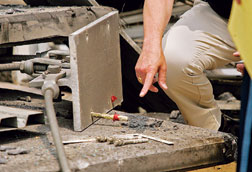|
The National Transportation Safety Board found on July 10 that improper epoxy use, poor or misleading product information and lack of follow-up inspections were the critical factors that led to a fatal Interstate 90 tunnel plenum collapse in Boston last year. The NTSB board unanimously adopted the 171-page report, which includes 20 findings and 20 safety recommendations.
In a five-hour meeting, held one year to the day after the collapse, the board determined that the pullout failure of twenty 8-in.-long threaded stainless-steel epoxied bolt anchors precipitated the collapse. Ten precast concrete panels and hardware weighing 52,000 lb killed Milena Del Valle, a 38-year-old mother of three, and injured her husband (ENR 7/24/06 p. 10). The board noted that there was exeptionally poor creep resistance in the fast-set epoxy used to anchor the bolts and that while short-term strength was verified through proof testing, the bolts ultimately yielded to a slow and steady pull over the six years following installation. The board also said that the state could have detected the problem and corrected it if it had an inspection system in place between 2003 and 2006.
 The Massachusett's Governors office Using the wrong epoxy led to long-term deformation and failure in the I-90 tunnel plenum that killed a 38-year-old local woman. |
NTSB also pointed out that major safety issues included an insufficient understanding among designers and builders of the nature of adhesive anchoring systems, a lack of anchor-testing standards in sustained tensile-load applications, inadequate regulatory requirements for tunnel inspections and a lack of national standards for the design of tunnel finishes. The board recommended that the Federal Highway Administration establish a national mandatory tunnel inspection program similar to its bridge inspection program and that the agency work with state officials to develop guidelines for tunnel finishes. It also urged the development of testing standards for adhesive anchors used in sustained overhead load applications and prohibited their use until safety protocols have been implemented.
NTSB reviewed over 400,000 pages of construction documents for the study. The board noted that while the design was sufficient, the fast-set epoxy used was not appropriate. Epoxy is formed by the chemical re-action between a resin and hardener. But epoxy deforms under constant load, and the material begins to fracture in a process called "creep."
 AP/Worldwide Inspection and repair work cost contractors an estimated $54 million to correct epoxy problems. |
CA/T officials, designers and contractors knew they had a problem in 1999 and in 2001 when several anchors deformed in the 200-ft-long tunnel portal section, but they thought it was an installation problem, not an epoxy problem.
Powers Fasteners Inc., Brewster, N.Y., which distributes the epoxy and anchorage system as an engineered product, had its fast-set and standard-set epoxies creep-tested in 1995-1996. The fast-set failed, and that should have precluded its use in 1999 on the I-90 tunnel, according to NTSB. After the 1999 and 2001 failures, project consultant Bechtel/Parsons Brinckerhoff and tunnel contractor Modern Continental Construction Co. Inc., Cambridge, Mass., should have instituted a monitoring program but did not. "Use of an inappropriate epoxy formulation resulted from the failure of [designer] Gannett Fleming Inc. [Harrisburg, Pa.] and Bechtel Parsons/Brinckerhoff to identify potential creep in the anchor adhesive as a critical long-term failure mode, and to account for possible anchor creep in the design, specifications and approval process for the epoxy anchors used in the tunnel," says NTSB. "Powers Fasteners Inc. [also] failed to provide the CA/T project with sufficiently complete, accurate and detailed information about the suitability of the company's fast-set epoxy for sustaining long-term tensile loads."
 Essdras Suarez/The Boston Globe |
Powers, in a press release, states that it supplied standard-set epoxy and did not know that fast-set epoxy was being used.
The fatal plenum collapse led former Massachusetts Attorney General Thomas F. Reilly to file a civil lawsuit on Nov. 28, 2006, against 15 firms, including B/PB, Gannett Fleming, Modern and Powers, for negligence in management, design, construction and oversight. Reilly's successor, Martha Coakley, is conducting her own criminal investigation. The Del Valle family and lawyers have been meeting with legal teams in an attempt to reach a settlement out of court.
Following the collapse, a number of state and federal agencies inspected the tunnel. They found that over 1,100 epoxy anchors were problematic. Mechanical undercut anchors were installed as a redundant support system. The tunnel was reopened in June 2007.

Post a comment to this article
Report Abusive Comment